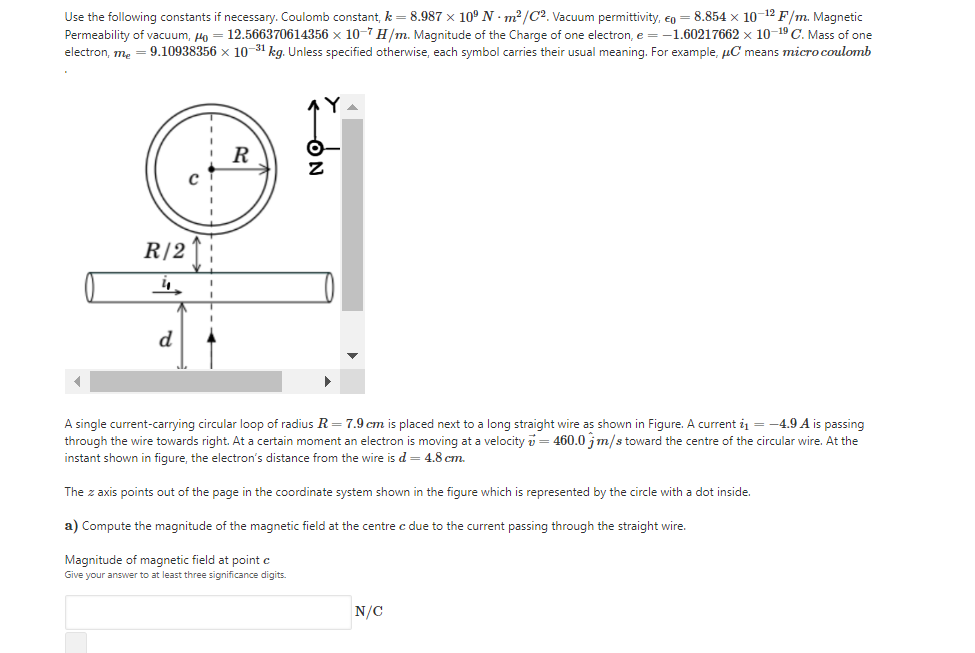A single current-carrying circular loop of radius R= 7.9 cm is placed next to a long straight wire as shown in Figure. A current i = -4.9 A is passing through the wire towards right. At a certain moment an electron is moving at a velocity v = 460.0 jm/s toward the centre of the circular wire. At the instant shown in figure, the electron's distance from the wire is d = 4.8 cm. The z axis points out of the page in the coordinate system shown in the figure which is represented by the circle with a dot inside.
A single current-carrying circular loop of radius R= 7.9 cm is placed next to a long straight wire as shown in Figure. A current i = -4.9 A is passing through the wire towards right. At a certain moment an electron is moving at a velocity v = 460.0 jm/s toward the centre of the circular wire. At the instant shown in figure, the electron's distance from the wire is d = 4.8 cm. The z axis points out of the page in the coordinate system shown in the figure which is represented by the circle with a dot inside.
Principles of Physics: A Calculus-Based Text
5th Edition
ISBN:9781133104261
Author:Raymond A. Serway, John W. Jewett
Publisher:Raymond A. Serway, John W. Jewett
Chapter22: Magnetic Forces And Magnetic Fields
Section: Chapter Questions
Problem 27P
Related questions
Question
100%

Transcribed Image Text:d) Calculate the magnitude and direction of the current to the circular wire to produce zero magnetic field at its centre c. Consider counter-clockwise
circulation of current as positive.
Value of the current (with sign)
Give your answer to at least three significance digits.
A

Transcribed Image Text:Use the following constants if necessary. Coulomb constant, k = 8.987 x 10° N · m?/C2. Vacuum permittivity, en = 8.854 x 10-12 F/m. Magnetic
Permeability of vacuum, 4o = 12.566370614356 x 10-7 H/m. Magnitude of the Charge of one electron, e = -1.60217662 x 10-19 C. Mass of one
9.10938356 x 10-31 kg. Unless specified otherwise, each symbol carries their usual meaning. For example, µC means microcoulomb
electron, me
R
R|2 ↑ :
d
A single current-carrying circular loop of radius R = 7.9 cm is placed next to a long straight wire as shown in Figure. A current i = -4.9A is passing
through the wire towards right. At a certain moment an electron is moving at a velocity v = 460.0 jm/s toward the centre of the circular wire. At the
instant shown in figure, the electron's distance from the wire is d = 4.8 cm.
The z axis points out of the page in the coordinate system shown in the figure which is represented by the circle with a dot inside.
a) Compute the magnitude of the magnetic field at the centre c due to the current passing through the straight wire.
Magnitude of magnetic field at point e
Give your answer to at least three significance digits.
N/C
Expert Solution
This question has been solved!
Explore an expertly crafted, step-by-step solution for a thorough understanding of key concepts.
This is a popular solution!
Trending now
This is a popular solution!
Step by step
Solved in 3 steps with 3 images

Knowledge Booster
Learn more about
Need a deep-dive on the concept behind this application? Look no further. Learn more about this topic, physics and related others by exploring similar questions and additional content below.Recommended textbooks for you

Principles of Physics: A Calculus-Based Text
Physics
ISBN:
9781133104261
Author:
Raymond A. Serway, John W. Jewett
Publisher:
Cengage Learning

Physics for Scientists and Engineers: Foundations…
Physics
ISBN:
9781133939146
Author:
Katz, Debora M.
Publisher:
Cengage Learning


Principles of Physics: A Calculus-Based Text
Physics
ISBN:
9781133104261
Author:
Raymond A. Serway, John W. Jewett
Publisher:
Cengage Learning

Physics for Scientists and Engineers: Foundations…
Physics
ISBN:
9781133939146
Author:
Katz, Debora M.
Publisher:
Cengage Learning


College Physics
Physics
ISBN:
9781938168000
Author:
Paul Peter Urone, Roger Hinrichs
Publisher:
OpenStax College

Physics for Scientists and Engineers
Physics
ISBN:
9781337553278
Author:
Raymond A. Serway, John W. Jewett
Publisher:
Cengage Learning

Physics for Scientists and Engineers with Modern …
Physics
ISBN:
9781337553292
Author:
Raymond A. Serway, John W. Jewett
Publisher:
Cengage Learning